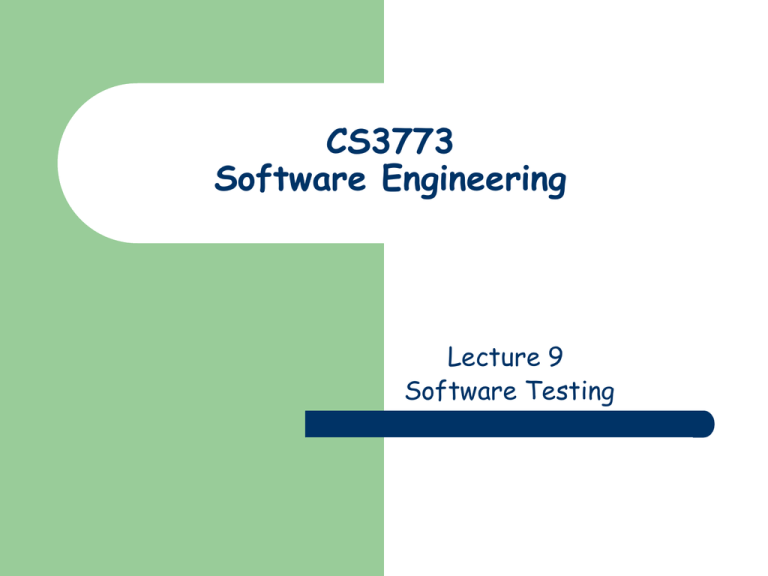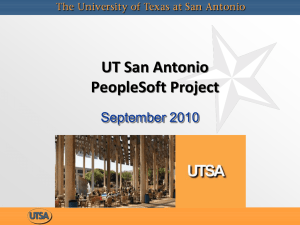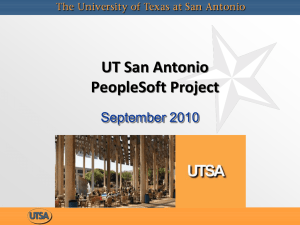Lecture 09 Software Testing and Quality Assurance
advertisement

CS3773
Software Engineering
Lecture 9
Software Testing
Software Verification and Validation
Software verification and validation ( V & V) techniques are
applied to improve the quality of software
V & V takes place at each stage of software process
2
–
Requirements analysis
–
Design analysis
–
Implementation checking
Inspection
Testing
UTSA CS3773
Goal of Verification and Validation
Establish confidence that the software systems is “fit for
purpose”
–
Software function
–
User expectations
–
Marketing environment
Two verification and validation ( V & V) approaches
–
Software inspections or peer reviews
–
Software testing
3
Manual or automated
Exercising program using data and discovering defects through output
UTSA CS3773
V & V versus Debugging
V & V process are interleaved with debugging
V & V process are intended to establish the existence of
defects in a software system
Debugging is a process that locates and corrects these
defects
4
–
Patterns in the test output
–
Design additional tests
–
Trace the program manually
–
Use debugging tools
UTSA CS3773
Software Inspection
Software inspection is a static process
Compared with testing, software inspections have some
advantages
5
–
During testing, errors can hide other errors; during inspection, a
single session can discover many error
–
During testing, you have to develop test harnesses to test
available parts; during inspection, incomplete system can be
checked without additional cost
–
During testing, only program defects are disclosed; during
inspection, broader quality attributes are considered
UTSA CS3773
Program Inspection
Manual program inspection detects defects, other types of
inspections may be concerned with schedule, costs, etc.
6
Manual program inspection is carried out by a team
Program inspection activities
–
Planning
–
Overview
–
Individual preparation
–
Inspection meeting
–
Rework
–
Follow-up
UTSA CS3773
Issues of Program Inspection
7
Have a precise specification of the code to be inspected
Inspection team members are familiar with the
organizational standards
Compilable version of the code has to be distributed to all
team members
Program inspection is driven by checklist of errors
Program inspection should focus on defect detection,
standards conformance, and poor quality programming
UTSA CS3773
Automated Static Analysis
Automated static analysis tools scan the source code and
detect possible faults and anomalies, such as variables used
without initialization
8
–
Statements are well-formed
–
Make inference about the control flow
–
Compute the set of all possible values for program data
Static analysis complements the error detection facilities
provided by compiler
UTSA CS3773
Activities in Static Analysis
Control flow analysis: loop identification
–
Data use analysis: highlighting variables
–
9
e.g., Unreachable code
e.g., Variables declared but never used
Type checking
Information flow analysis: detecting dependencies between
input and output variables
Path analysis: path examination
UTSA CS3773
Verification and Formal Methods
Formal methods are mathematical notations and analysis
techniques for enhancing the quality of systems
Confidence in software can be obtained by using formal
methods
10
–
Formal methods are rigorous means for specification and
verification
–
Formal requirements models can be automatically analyzed and
requirement errors are easier and cheaper to fix at the
requirement stage
–
Powerful tools (e.g., model checkers) have been increasingly
applied in modeling and reasoning about computer-based systems
UTSA CS3773
Software Testing
Testing is the most commonly used validation technique
Testing is an important part of the Software Lifecycle
11
Testing is the process of devising a set of inputs to a given
piece of software that will cause the software to exercise
some portion of its code
The developer of the software can then check that the
results produced by the software are in accord with his or
her expectations
UTSA CS3773
Testing Levels Based on Test Process Maturity
12
Level 0 : There’s no difference between testing and
debugging
Level 1 : The purpose of testing is to show correctness
Level 2 : The purpose of testing is to show that the
software doesn’t work
Level 3 : The purpose of testing is not to prove anything
specific, but to reduce the risk of using the software
Level 4 : Testing is a mental discipline that helps all IT
professionals develop higher quality software
UTSA CS3773
Software Testing Objectives
Find as many defects as possible
Find important problems fast
Assess perceived quality risks
Advise about perceived project risks
Certify to a given standard
13
Assess conformance to a specification (requirements,
design, or product claims)
UTSA CS3773
Software Testing Stages
Unit testing
–
Integration testing
–
Testing to expose problems arising from the combination of
components
System testing
–
Testing the overall functionality of the system
Acceptance testing
–
14
Testing of individual components
Testing by users to check that the system satisfies
requirements. Sometimes called alpha testing
UTSA CS3773
Software Testing Activities
15
Test planning: design test strategy and test plan
Test development: develop test procedures, test scenarios,
test cases, and test scripts to use in testing software
Test execution: execute the software based on the plans
and test cases, and report any errors found to the
development team
Test reporting: generate metrics and make final reports on
their test effort and whether or not the software tested is
ready for release
Retesting the revised software
UTSA CS3773
Test Case
Input values
Expected outcomes
–
Things created (output)
–
Things changed/updated database?
–
Things deleted
–
Timing
…
16
Environment prerequisites: file, net connection …
UTSA CS3773
Design Test Case
Build test cases (implement)
–
Implement the preconditions (set up the environment)
–
Prepare test scripts (may use test automation tools)
Structure of a test case
Simple
(I, EO)
linear
{(I1, EO1), (I2, EO2), …}
Tree
I
EO1
17
EO2
UTSA CS3773
Test Script
Scripts contain data and instructions for testing
–
Comparison information
–
What screen data to capture
–
When/where to read input
–
Control information
–
18
Repeat a set of inputs
Make a decision based on output
Testing concurrent activities
UTSA CS3773
Test Results
Compare (test outcomes, expected outcomes)
19
–
Simple/complex (known differences)
–
Different types of outcomes
Variable values (in memory)
Disk-based (textual, non-textual, database, binary)
Screen-based (char., GUI, images)
Others (multimedia, communicating apps.)
UTSA CS3773
Software Testing Techniques
Functional testing is applied to demonstrate the system
meets its requirements, it is also called black-box testing
–
Testers are only concerned with the functionality, performance,
and dependability
–
The system is treated as a black box that takes input and
produces output
Structural testing is applied to expose defects and tests are
derived from the knowledge of the internal workings of items
20
–
Testers understand the algorithm and the structure of systems
–
The system is treated as a white box
UTSA CS3773
Functional Testing
Boundary value testing
21
–
Boundary value analysis
–
Robustness testing
–
Worst case testing
–
Special value testing
Equivalence class testing
Decision table based testing
UTSA CS3773
Boundary Value Analysis
Errors tend to occur near the extreme values of an input
variables
Boundary value analysis focuses on the boundary of the input
space to identity test cases
Boundary value analysis selects input variable values at their
22
–
Minimum
–
Just above the minimum
–
A nominal value
–
Just below the maximum
–
Maximum
UTSA CS3773
Example of Boundary Value Analysis
Assume a program accepting two inputs y1 and y2, such that
a < y1< b and c < y2 < d
y2
d
c
..
.. ..
.
a
23
..
b
y1
UTSA CS3773
Single Fault Assumption for Boundary Value Analysis
Boundary value analysis is also augmented by the single fault
assumption principle
“Failures occur rarely as the result of the simultaneous
occurrence of two (or more) faults”
In this respect, boundary value analysis test cases can be
obtained by holding the values of all but one variable at their
nominal values, and letting that variable assume its extreme
values
24
UTSA CS3773
Generalization of Boundary Value Analysis
The basic boundary value analysis can be generalized in two
ways:
25
–
By the number of variables - (4n +1) test cases for n variables
–
By the kinds of ranges of variables
Programming language dependent
Bounded discrete
Unbounded discrete (no upper or lower bounds clearly defined)
Logical variables
UTSA CS3773
Limitations of Boundary Value Analysis
Boundary value analysis works well when the program to be
tested is a function of several independent variables that
represent bounded physical quantities
Boundary value analysis selected test data with no
consideration of the function of the program, nor of the
semantic meaning of the variables
We can distinguish between physical and logical type of
variables as well (e.g. temperature, pressure speed, or PIN
numbers, telephone numbers etc.)
26
UTSA CS3773
Robustness Testing
27
Robustness testing is a simple extension of boundary value
analysis
In addition to the five boundary value analysis values of
variables, we add values slightly greater that the maximum
(max+) and a value slightly less than the minimum (min-)
The main value of robustness testing is to force attention on
exception handling
In some strongly typed languages values beyond the
predefined range will cause a run-time error
UTSA CS3773
Example of Robustness Testing
y2
d
c
..
... ..
..
a
28
…
b
y1
UTSA CS3773
Worst Case Testing
29
In worst case testing we reject the single fault assumption
and we are interested what happens when more than one
variable has an extreme value
Considering that we have five different values that can be
considered during boundary value analysis testing for one
variable, now we take the Cartesian product of these
possible values for 2, 3, … n variables
We can have 5n test cases for n input variables
The best application of worst case testing is where physical
variables have numerous interactions
UTSA CS3773
Example of Worst Case Testing
y2
d
c
....
....
..
a
30
..
..
.
....
....
..
b
y1
UTSA CS3773
Special Value Testing
Special value testing is probably the most widely practiced
form of functional testing, most intuitive, and least uniform
Utilizes domain knowledge and engineering judgment about
program’s “soft spots” to devise test cases
Event though special value testing is very subjective on the
generation of test cases, it is often more effective on
revealing program faults
31
UTSA CS3773
Equivalence Class Testing
The use of equivalence class testing has two motivations:
–
Sense of complete testing
–
Avoid redundancy
Equivalence classes form a partition of a set that is a
collection of mutually disjoint subsets whose union is the
entire set
Two important implications for testing:
32
–
The entire set is represented provides a form of completeness
–
The disjointness assures a form of non-redundancy
UTSA CS3773
Example of Equivalence Class Testing
The program P with 3 inputs: a, b and c and the
corresponding input domains are A, B, and C
A A1 A 2 A 3
B B1 B 2
C C1 C 2 C 3 C 4
33
UTSA CS3773
Example of Equivalence Class Testing
Define a1, a2 and a3 as:
34
–
let ai be a “representative” or “typical” value within its
respective equivalence class (e.g. the midpoint in a linear
equivalence class).
–
similarly define bi and ci.
Test cases can be stated for the inputs <a,b,c> in terms
of the representative points
The basic idea behind the techniques is that one point
within an equivalence class is just as good as any other
point within the same class
UTSA CS3773
Decision Table
Decision tables make it easy to observe that all possible
conditions are accounted for
Decision tables can be used for:
–
Specifying complex program logic
–
Generating test cases (Also known as logic-based testing)
Logic-based testing is considered as:
–
structural testing when applied to structure, i.e. control flow
graph of an implementation
–
35
functional testing when applied to a specification
UTSA CS3773
Decision Table Usage
The use of the decision-table model is applicable when :
–
Specification is given or can be converted to a decision table
–
The order in which the predicates are evaluated does not
affect the interpretation of the rules or resulting action
–
The order of rule evaluation has no effect on resulting action
–
Once a rule is satisfied and the action selected, no other rule
need be examined
–
The order of executing actions in a satisfied rule is of no
consequence
36
UTSA CS3773
Example of Decision Table
Conditions
Printer does not print
Y
Y Y Y N N N
N
A red light is flashing
Y
Y N N Y Y N
N
Printer is unrecognized
Y
N Y N Y N Y
N
Heck the power cable
Actions
Check the printer-computer cable
X
X
Ensure printer software is installed
X
X
Check/replace ink
X
Check for paper jam
37
X
X
X
X
X
X X
X
Printer Troubleshooting
UTSA CS3773
Structural Testing
Program Flow Graph Testing
38
–
Basis Path Testing
–
Decision-to-Decision Path
–
Test Coverage Metrics
Data Flow Testing
UTSA CS3773
Program Flow Graph
39
“Given a program written in an imperative programming
language, its Program Graph, is a directed labeled graph in
which nodes are either groups of entire statements or
fragments of a statement, and edges represent flow of
control” – by P. Jorgensen
If i, j, are nodes (basic block) in the program graph, there is
an edge from node i, to node j in the program graph if an
only if, the statement corresponding to node j, can be
executed immediately after the last statement of the group
of statement(s) that correspond to node i.
UTSA CS3773
Determine the Basic Block
FindMean (FILE ScoreFile)
{ float SumOfScores = 0.0;
int NumberOfScores = 0;
1
float Mean=0.0; float Score;
Read(ScoreFile, Score);
2 while (! EOF(ScoreFile) {
3 if (Score > 0.0 ) {
SumOfScores = SumOfScores + Score;
NumberOfScores++;
}
5
Read(ScoreFile, Score);
4
6
}
/* Compute the mean and print the result */
7 if (NumberOfScores > 0) {
Mean = SumOfScores / NumberOfScores;
printf(“ The mean score is %f\n”, Mean);
} else
printf (“No scores found in file\n”);
9
UTSA
CS3773
}
8
40
Example of Program Flow Graph
Start
1
F
2
T
3
T
F
5
4
6
7
T
F
9
8
41
Exit
UTSA CS3773
Path Testing
42
Path Testing is focusing on test techniques that are based
on the selection of test paths through a program graph. If
the set of paths is properly chosen, then we can claim that
we have achieved a measure of test thoroughness
The fault assumption for path testing techniques is that
something has gone wrong with the software that makes it
take a different path than the one intended
Structurally, a path is a sequence of statements in a
program unit. Semantically, a path is an execution instance
of the program unit. For software testing we are interested
in entry-exit paths
UTSA CS3773
Path Testing Process
Unit Input:
–
Process:
43
Source code and a path selection criterion
–
Generation of a Program Flow Graph (PFG)
–
Selection of Paths
–
Generation of Test Input Data
–
Feasibility Test of a Path
–
Evaluation of Program’s Output for the Selected Test Cases
UTSA CS3773
Example for a Simple PFG
V(G) = 3
1
Basis set:
1, 2, 3, 4, 6, 7
1, 2, 3, 4, 5, 4, 6, 7
1, 2, 6, 7
x = z+5
z = 4*3-y
x>z
2
t
x = z+5
z = 4*3-y
if(x > z) goto A;
for( u=0; u < x; u++) {
z = z+1;
};
A: y = z + k
z = z+1
u++
6
f
R1
R2
3
5
t
R3
u=0
4
y = z+k
f
7
u<x
UTSA CS3773
44
Decision-to-Decision Path
A DD-Path is a chain obtained from a program graph, where a
chain is a path in which the initial and terminal nodes are
distinct, and every interior node has indegree = 1, and
outdegree = 1
Internal node is 2-connected to every other node in the
chain, and there are no instances of 1- or 3- connected nodes.
45
–
Feasibility Test of a Path
–
Evaluation of Program’s Output for the Selected Test Cases
DD-Paths are used to create DD-Path Graphs.
UTSA CS3773
Decision-to-Decision Path Graph
Given a program written in an imperative language, its DD-
Path graph is a labeled directed graph, in which nodes are
DD-Paths of its program graph, and edges represent control
flow between successor DD-Paths
In this respect, a DD-Path is a condensation graph. For
example 2-connected program graph nodes are collapsed to a
single DD-Path graph node
46
UTSA CS3773
Example of Path Graph
4
8
9
10
11
5
13
12
6
15
14
7
21
17
16
18
19
first
20
22
A
A
B
E
C
D
G
F
I
H
L
J
last
Program Graph
Nodes
DD-Path
Name
Case #
4
first
1
5-8
A
5
9
B
4
10
C
4
11
D
3
12-14
E
5
15
F
4
16
G
3
17
H
4
18
I
3
19
J
4
20
K
3
21
L
4
22
last
2
K
UTSA CS3773
47
Test Coverage
The motivation of using DD-paths is that they enable very
precise descriptions of test coverage
In our quest to identify gaps and redundancy in our test
cases as these are used to exercise (test) different aspects
of a program we use formal models of the program
structure to reason about testing effectiveness
Test coverage metrics are a device to measure the extend
to which a set of test cases covers a program
48
UTSA CS3773
Test Coverage Metrics
49
Metric
Description of Coverage
C0
Every Statement
C1
Every DD-Path
C1 P
Every predicate to each outcome
C2
C1 Coverage + loop coverage
Cd
C1 Coverage + every dependent pair of
DD-Paths
CMCC
Multiple condition coverage
Cik
Every program path that contains up to
k repetitions of a loop (usually k=2)
Cstat
“Statistically significant” fraction of
paths
C∞
All possible execution paths
UTSA CS3773
Data Flow Testing
Data flow testing refers to a category of structural testing
techniques that focus on the points of the code variables
obtain values (are defined) and the points of the program
these variables are referenced (are used)
–
–
50
Around faults that may occur when a variable is defined and
referenced in not a proper way
A variable is defined but never used
A variable is used but never defined
A variable that is defined twice (or more times) before it is used
Parts of a program that constitute a slice – a subset of program
statements that comply with a specific slicing criterion (i.e. all
program statements that are affected by variable x at point P)
UTSA CS3773
Data Flow Testing Process
Data-flow testing involves selecting entry/exit paths with
the objective of covering certain data definition and use
patterns, commonly known as data-flow criteria
An outline of data-flow testing is as follows:
–
Draw a data flow graph for the program
–
Select data-flow testing criteria
–
Identify paths in the data-flow graph to satisfy the selection
criteria
–
51
Produce test cases for the selected paths
UTSA CS3773
Reading Assignments
Sommerville’s Book, 8th edition
–
–
Somerville’s Book, 9th edition
–
52
Chapter 22, “Software Inspection”
Chapter 23, “Software Testing”
Chapter 8, “Software Testing”
UTSA CS3773







